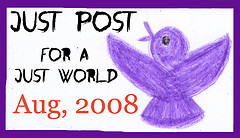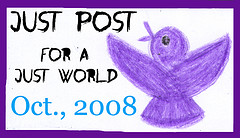Monday was a wet day in Southeast Louisiana.
Big rains out-performed city pumps, drains stopped up, and water was everywhere. Paul and I had proceeded with the days plans: taking the kids to school (after which Paul picked up a teacher who was stranded), then doing some errands which included getting some birthday provisions for a teacher. The phones/internet went out and we couldn’t work. The city shut down. We had lunch out and realized getting home was going to be very tough… if at all possible. We had several close calls where we were concerned about our car flooding and/or shorting out. We were lucky (and Paul is both smart and a very good driver.)
The day highlighted the vulnerability of this place, how our lives carry more similarities to life in a city in Central or South American than in United States. This is not because this, or any other place, is by itself more vulnerable. It is that the preparedness, ability to cope, and overall infrastructure has been weakened or lessened to the point that we are more vulnerable to crisis in the face of a natural occurrence*. But back to Monday.
After a good half hour of fighting the flood waters, we decided to go back to Abeona (or at least try) as they were forecasting more rain for the evening. We were worried that getting the kids in a few hours could be difficult (or impossible… or maybe impassable) so we went to the school, hung out until the rain had backed off a bit, then took them home. It made for a good afternoon of puddle-jumping. (Note: our street was very dry, and by this time, the rain had stopped and the entire city had practically shut down.)
The rains delayed in-coming flights, but only by a few hours — the guest faculty for our course arrived and joined us for dinner and course planning. She even brought Empire Apples, freshly picked, from Michigan! Tuesday’s session went well — complete with students turning in first assignments (that was today’s work.) I am very thankful to have a second Teaching Assistant this term!
*So to those who would compare the horrible crisis of the South California fires to Katrina are just completely off-base; although both are certainly natural disasters, they are completely different in everyway. Katrina itself was a natural disaster, heightened by a man-made disaster (the failure of the levees). The structural and social vulnerabilities here, coupled with the (arguably deliberate) nonresponse of federal resources, created a dire situation. People were not at risk and dying due to the direct impact of a natural disaster, but the influence of a man-made disaster and the exposure which followed. People were left to die trapped in their attics and exposed for days outside emergency shelters, isolated by water and storm debris. In many cases, they left quickly without provisions, food, water, or medicine, or left with only what they could carry. The desperation and fear in this scenario are incomparable to other modern domestic disasters. This is very different than Southern California, which is facing daunting fire and relatively low ratios of home loss compared to that of the home loss due to Katrina and the levee failures (ARC estimated more than 350,000 homes were destroyed in Katrina and the flood; CNN reports approximately 1430 homes destroyed in the California fires, and although those numbers will rise, it is doubtful that they will carry the same percentage of loss seen in New Orleans, who had 80% complete city destruction due to flood waters and significant storm damage and debris in the rest). Additionally, the temporary shelter activities in Southern California are occurring with passable roadways, people in good health who had time to pack for evacuation, staying in climate-controlled shelters with electricity, access to water, and other important resources. (Not to mention entertainment, psychological support, and even masseurs?) Comparing the two is not only impossible, but it implies a slippery slope reflecting the people involved in the scenarios, rather than the overall structure that each disaster occurred within.















Chris S. | 25-Oct-07 at 8:36 am | Permalink
OK, I’ll bite, being the resident SoCal guy. I’m not sure I buy your conclusion. The details that make Katrina a unique situation does not mean the totality of it cannot be compared to the SoCal fires, because it can. After all, the SoCal fires have unique aspects as well.
The structure for analysis, as I see it, is that California has a much more competent and motivated government at the state and local levels, is better coordinated with the federal government, has more disaster planning experience, and has more resources than Louisiana, when it comes to dealing with natural disasters. That is why the California wildlife response differed from Louisiana’s response to Katrina.
A few other quibbles … You say that California roadways are passable. I would strenuously disagree! Have you ever driven in Southern California? These fires have occurred near population centers that are usually clogged with traffic up to 18 hours a day. The 5, the 101, the PCH, the 10, the 15, the 118 … they’re not like a Sunday drive in the park! Sure, floodwaters will stop your car, but so will another car that’s stopped in front of yours, and 200 others in front of that. Both situations are equally dangerous concerns in evacuation scenarios.
You say that the evacuees are in good health. That’s a general claim, so I don’t understand precisely what you mean … but surely within the large populations of Los Angeles, Ventura, San Bernardino, Imperial and San Diego counties, you do have a good deal of people with pre-existing health problems that pose difficulties in evacuating. And remember … over 1 MILLION PEOPLE … have had to evacuate so far. I would add that large wildfires do pose a special threat due to the toxins that they dump into the air. Obviously that’s a public health concern, particularly to the young, elderly and sick. Even here in the Valley, we’re wheezing, and I’m generally a healthy guy in terms of physical shape.
As for time to pack for evacuation … read the accounts in the Los Angeles Times and on news stations like KNBC.com. Many of the people who had to evacuate got this message. Knock on the door. Hello? “There’s a fire. Get out now.” Cool, can I grab a few things? “Not unless you want to die. Leave now.” Sure, some people had time to pack up just in case they had to evacuate … but the same was true during Katrina. No one foresaw the magnitude of flooding that occurred in Nola and other parishes, but we all down South are smart enough to know, from enough examples, that hurricanes are unpredictable, and when a Hurricane Watch is issued, you need to make plans. If you don’t, unfortunately, you take your chances. As for the people who couldn’t evacuate, that’s another post.
As for the rest of the claims … better shelters, access to better resources … that’s obviously a function of California’s wealth as a state and careful planning. The state is experienced dealing with large scale, major natural disasters, much more so than Louisiana, so it’s given responses a lot of thought. Being the 7th largest economy in the world doesn’t hurt, either. Obviously Louisiana is an impoverished state. That harms disaster response.
Cold Spaghetti | 25-Oct-07 at 9:15 am | Permalink
So after listing all of this dis-similarities, what exactly about the two crises do you find as similar? Besides the fact that they are both disasters which have caused havoc?
It’s not a pissing contest. Both are terrible events. My issue is with the claims that Southern California is reacting “civilized” while the post-K disaster in NOLA was chaos. These are pointed terms, suggesting that those involved with Katrina are less civilized than the folks in San Diego… comments influenced by racism, classism, and ignorance. CSM, I know you are clued into this, because that is what the rhetoric is about.
And roughly TWO million people evacuated for Katrina. More than twice that have been displaced (for a relatively short time) by the fires. And Californians had immediate assistance (versus five days for federal response). Remember, local resources were destroyed. There was little anyone locally could do.
So I ask again, in a situation that is completely different, what, if anything, is there to compare? (Unless you are trying to further an agenda that disavows the negligence of the federal government or furthers racist and classist bigotry?)
Chris S. | 25-Oct-07 at 10:41 am | Permalink
Apples and oranges, despite their identifiable differences, are both fruit that grow on trees. Men and women are quite different, but they also are comparable. So are countries. Most of the things around us in the world are different, but that doesn’t mean we can’t compare them in certain appropriate frameworks.
What can be compared is how two sets of government entities responded to a major disaster. What were the reasons why New Orleans was ill equipped to handle the Katrina aftermath. Local infrastructure destroyed? Why didn’t they have a backup plan? Does infrastructure not get destroyed in hurricanes, tornadoes, earthquakes, wildfires, floods? That’s why you have to have a backup plan as state and local entities! The Weather Service has been saying since at least the 1960s that New Orleans and its infrastructure could be wiped out in a major hurricane. Were people in leadership not paying attention? There’s no question the federal government botched their part of the deal. But they alone can’t take all the blame. I’m not furthering an agenda. I’m just being a realist.
I’m not commenting on the idea that some feel that Southern Californians are somehow more civilized than New Orleanians. People say lots of things … nothing new. That attitude actually transcends disasters. SoCal has always believed it’s better than the rest of America, much as New Yorkers do, much as Houstonians do, Boston, etc … Southern California is a fairly diverse area, so I assume it’s more of a class argument you’re making than purely racial aspects.
As for the idea that the federal government deals unequally with its citizens … what’s earth shaking about that? Why is that a revelation now? Why was that a revelation in 2005? And why would people depend on the federal government to do anything, when we know that’s the case?
Matt | 25-Oct-07 at 5:48 pm | Permalink
I thought you might enjoy reading this post by Ian Welsh.
Cold Spaghetti | 26-Oct-07 at 6:50 am | Permalink
Now that is a nice comparison. Thanks, Matt.